Who said that spotting scopes were only used for hunting, astronomy or bird watching? In reality, this portable telescope, both practical and complete, offers countless possibilities of use. Straight or angled, there is no lack of choice, which sometimes leads to a headache for the buyer. To make it easier for you, check out our guide to the best spotting scopes.
Here is our commitment, to make sure that we provide the best user experience and content quality:
You can support us by using our links to make your purchases (at no extra cost to you)! This sometimes earns us a commission which allows us to remain independent. More about us
Our selection
"The Celestron Regal M2 65ED is a slant view spotting scope. It combines a high transmission optical path and a nitrogen-filled magnesium alloy housing to…"
"The 20-60X60HD spotting scope is sold with a tripod. This way, you can easily adjust the magnification power from 20x to 60x. In addition, this…"
"The HD ATS-80 25-50×80 mm rifle scope from Swarovski is a robust yet refined scope. The quality is not surprising when you know that the…"
"The Bresser Pirsch 25-75×100 spotting scope with a 45° angle of view is ideal for long-range terrestrial spotting and observation or for amateur astronomy. Its…"

The Celestron Regal M2 65ED is a slant view spotting scope. It combines a high transmission optical path and a nitrogen-filled magnesium alloy housing to provide reliable imaging performance in low light or inclement weather.
See priceThe Celestron Regal M2 65ED is arguably one of the best performing spotting scopes on the market. Day or night, it provides the sharpest possible images. It features multi-coated optics, including BAK4 prisms and an ultra-low dispersion (ED) glass lens. The latter minimizes chromatic aberration and maximizes light gathering. Multiple layers of Celestron's proprietary XLT coating on each lens preserve brightness and deliver high-contrast images to the eyepiece.
This more powerful version of the Regal M2 spotting scope includes a 16-48x eyepiece ideal for medium to long range. The wide magnification range, comfortable 20mm eye relief and twisted rubber eyecup make this zoom eyepiece well suited for long range observations. The scope's standard 1.25-inch eyepiece mount accepts most astronomy eyepieces, allowing for an almost infinite number of optical configurations.
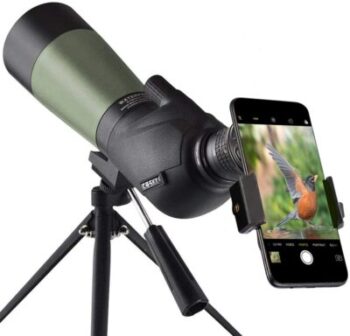
The 20-60X60HD spotting scope is sold with a tripod. This way, you can easily adjust the magnification power from 20x to 60x. In addition, this feature allows you to lock in your target perfectly, then zoom in to capture more detail.
See priceGosky offers us a cheap and very powerful spotting scope here, with 20x to 60x magnification power that allows you to easily lock on to your target and zoom in to see more detail. You can easily use it for target shooting, hunting, archery, wild mammal watching, bird watching, hiking, outdoor sports and many other recreational activities.
The Gosky 20-60X60HD features a 60mm long multi-coated lens. This lens supports a wide field of view to 1,000 meters. The included prismatic optics improve light transmission. So you'll get clear, bright and sharp images in the output, regardless of the lighting conditions. The 45° angled eyepiece provides comfortable viewing. Rubber armor and durable construction provide a non-slip grip. This type of construction provides excellent protection from the elements.

The HD ATS-80 25-50×80 mm rifle scope from Swarovski is a robust yet refined scope. The quality is not surprising when you know that the manufacturer of this scope is one of the most renowned in the world. If you can afford it, don't hesitate!
See priceThe 80mm configuration of the Swarovski ATS 80 HD is both robust and lightweight. Swarodur and Swarotop coatings on all lenses and prisms minimize glare while maximizing contrast. The Swaroclean lens coating makes it easy to remove dirt such as water marks, insect repellent or tree resin. This version of the STS-80 is offered without an eyepiece and is designed for users who already have optional 25-50x wide-angle or 20-60x zoom eyepieces and want to upgrade their scope body.
The durable, lightweight aluminum alloy chassis - wrapped in protective rubber armor - complements the optical performance and technologies. Its optical tubes are nitrogen-filled and their O-rings are sealed to be waterproof and dustproof, submersible, and resistant to internal fogging under extreme temperature changes or environmental conditions.
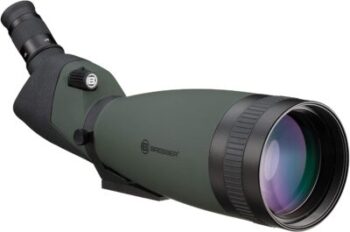
The Bresser Pirsch 25-75×100 spotting scope with a 45° angle of view is ideal for long-range terrestrial spotting and observation or for amateur astronomy. Its reasonable price will convince you.
See priceThis spotting scope has a powerful 25-75x zoom range that allows for viewing large areas at low power with the ability to zoom in and make detailed observations. The massive 100mm lens is optimized for low light conditions and to ensure that views remain bright when viewing distant subjects at high magnification. The traditional Porro prism optical path produces clear, bright views without internal light interference.
The BAK4 prism lens, meanwhile, offers a round exit pupil and a crisp, clear image with limited edge distortion. Fully multi-coated anti-reflective lens surfaces increase light transmission for accurate color representation and improved contrast and clarity. Field of view of 78′ at 1,000 yards on 25x power, 42′ on 75x.
Any specific needs?
The best spotting scope in 2021
The best entry-level spotting scope
The best high-end spotting scope
Your guide :
Rate this buying guide :By rating this buying guide, you are helping us to reward our best writers. Thank you!
| TOP OF THE LINE | CHEAP | TOP OF THE LINE | EXCELLENT | |

In accordance with our commitment, this buying guide does not contain any sponsored products. |
 8/10 |
 8/10 |
 9/10 |
 7/10 |
| OUR SELECTION |
Celestron Regal M2 65ED
|
Gosky 20-60X60HD
|
Swarovski ATS 80 HD
|
Bresser Pirsch 25-75x100 45°
|
|
The Celestron Regal M2 65ED is a slant view spotting scope. It combines a high transmission optical path and a nitrogen-filled magnesium alloy housing to provide reliable imaging performance in low light or inclement weather.
|
The 20-60X60HD spotting scope is sold with a tripod. This way, you can easily adjust the magnification power from 20x to 60x. In addition, this feature allows you to lock in your target perfectly, then zoom in to capture more detail.
|
The HD ATS-80 25-50×80 mm rifle scope from Swarovski is a robust yet refined scope. The quality is not surprising when you know that the manufacturer of this scope is one of the most renowned in the world. If you can afford it, don't hesitate!
|
The Bresser Pirsch 25-75×100 spotting scope with a 45° angle of view is ideal for long-range terrestrial spotting and observation or for amateur astronomy. Its reasonable price will convince you.
|
|
|
|
Fully multi-coated lenses, including BAK4 prisms
|
Wide field of view to 1000 meters
|
Very rugged yet lightweight
|
Ideal for long-range terrestrial spotting and observation or amateur astronomy
|
|
|
Celestron's exclusive XLT coating to preserve brightness
|
Non-slip grip
|
All lenses equipped with SWARODUR and SWAROTOP coatings
|
BAK4 prism glass
|
|
|
16-48x eyepiece ideal for medium and long range glass
|
Supplied with tripod
|
Durable, lightweight aluminum alloy frame
|
Optimized 100mm solid lens
|
Help us improve this table:
Report an error, request the addition of a feature to the table, or suggest another product. Thank you for your kindness!
We spend thousands of hours each year studying the major specialized websites, analyzing products of hundreds of brands and reading user feedback to advise you on the best products.
We are a product review company with a single mission: to simplify your buying decisions. Our research and testing helps millions of people every year find the best products for their personal needs and budget.
To support us you can: use our links to make your purchases (which often earns us a small commission), share our articles on social networks, or recommend our site on your blog. Thanks in advance for your support!
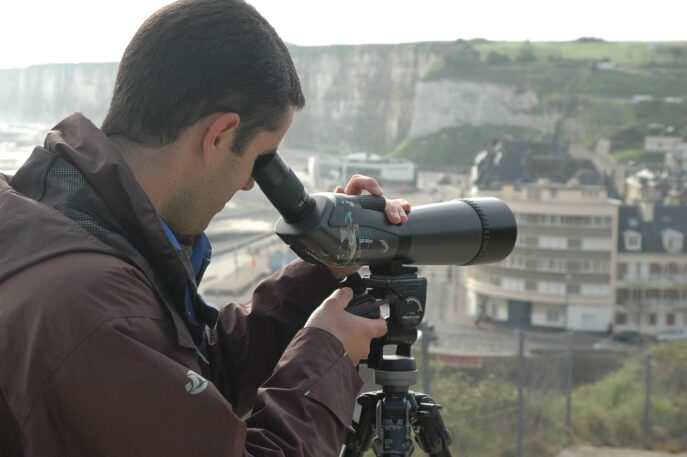
Telescopes are medium range telescopes, usually with a magnification power between 15x and 60x. To change the magnification power, they have either fixed-length interchangeable eyepieces or a single zoom eyepiece. While higher magnification extends the capabilities of a spotting scope, a 40-100 model is probably overkill if you're birding or hunting at close range. Also, consider that higher magnification will end up reducing image quality and a smaller field of view.
The quality of the glass used in a spotting scope makes a huge difference in the quality of the image delivered to your eye. Check the specifications provided by the manufacturer to make sure you are getting good lenses for the price. Ordinary glass blocks a certain amount of light from passing through it. Modern lens coatings improve light transmission, letting more light through and giving you a brighter image. All good glasses now use coated lenses, and multi-coated lenses are the gold standard. Poor quality lenses produce chromatic aberration. This "fringing" of colors around an object is produced by dispersion of the lens, with colors of different wavelengths passing through the glass unevenly and focusing on slightly different points. Good optics avoid this by using ED glass, which stands for Extra-Low Dispersion. With all colors focusing on the same point, the image is much sharper. Unfortunately, not all manufacturers use the same terminology and some may refer to their low dispersion lenses as HD, XD or APO. Check the term used by each brand to avoid disappointment.
While magnification refers to the range of a monocular telescope, the field of view determines the width of the image. Think about the activities you will use the scope for before you buy. If you hunt, will you use the scope to spot targets at a distance? If so, higher magnification and a smaller field of view may be best. However, if you are bird watching or hiking, less magnification is needed and a wide field of view may be useful. The field of view is usually given in degrees or as a unit of measurement at a certain distance (e.g., 39 m wide at 1,000 m distance).
Unlike
astronomical telescopes, spotting scopes are intended for use in the field. They can fall, bump into furniture, and are exposed to elements such as rain, fog, and mud. This makes the ruggedness of the housing, lens, lens cap and seals a vital consideration.
For a beginner, seeing a range of numbers describing a spotting scope can be confusing! Here is a simple explanation:
The main number you see will look something like 20-60 × 80.
The higher the magnification, the better the spotting scope will be and therefore probably more expensive. The same thing applies to the size of the lens. The larger it is, the better the image and clarification you will get.
For home use, spotting scopes with magnifications from 20x to 60x and lenses with diameters from 60mm to 80mm will do just fine. They are perfect for bird watching, hunting, game viewing, surveillance, harbor activities and even occasional astronomy.
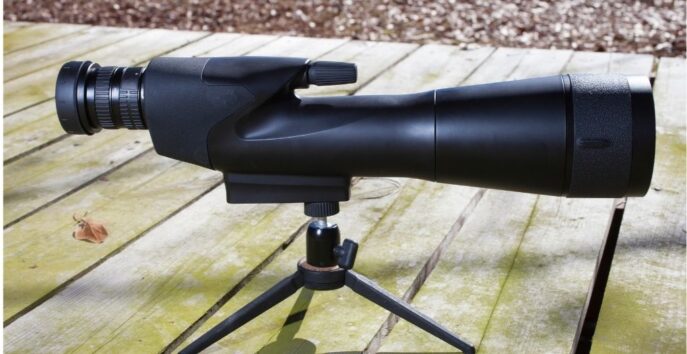
Straight scopes have the eyepiece and the scope body on the same horizontal optical plane. Sometimes the eyepiece is exactly level with the telescope body. Sometimes the eyepiece is at a higher level than the body like the Swarovski ATS 80 HD spotting scope, but it still maintains its horizontal optical design.
This type of spotting scope is suitable for all purposes, and all skill levels. They are particularly user-friendly and intuitive for beginners, as it is easier and faster to spot and track moving targets. The main drawback of this type of spotting scope is that it is difficult to see or target objects at high altitudes or above sea level.

Tilted spotting scopes usually have the eyepiece at a 45-degree angle to the scope body. It can be used at different heights without changing the length of the tripod. It offers more comfort of use when it is intended to see the angles by looking up. It can even be used effectively even in lowered positions - sitting or lying down.
The main disadvantage is that they are a little more difficult to use, because your line of sight is now on an angle, which makes it more difficult to detect moving targets. This type of spotting scope will work well for hunting, bird watching and occasional astronomy use.
Telescopes are like telescopes of a more modest size. They are also not as powerful, as they are not intended for stargazing. Also, telescopes are intended for night viewing, while spotting scopes have been modified to allow daytime viewing in the sun. They are lighter and are ideal for outdoor activities.
Like spotting scopes, binoculars are available in a wide range of sizes and magnification capabilities, although due to their smaller size, their overall magnification is not as close to that of some of the more powerful spotting scopes. However, binoculars have many advantages: reduced eyestrain, small footprint, light weight, and no need for a tripod to use them.
If you need a device with high magnification capability, choose a spotting scope. If portability and maneuverability are more important, look to binoculars.
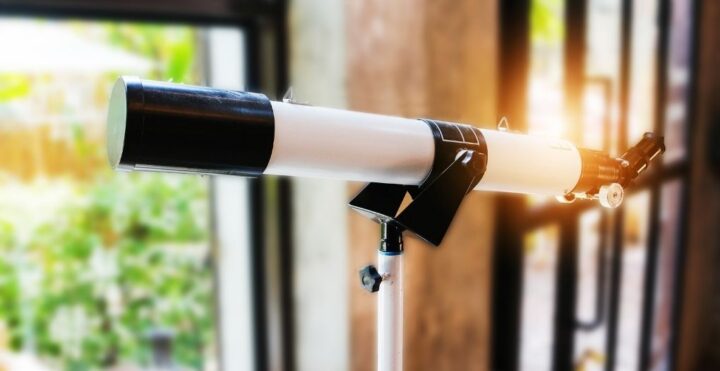
Clear image
The spotting scope offers everyone a clear image, faithful to reality, whether in terms of structure, light or colour. As it is a monocular optical instrument, it can achieve greater magnifications than a pair of binoculars.
Distinction of invisible details
It also offers everyone the possibility of distinguishing invisible details with binoculars, thanks to its magnification, thus allowing everyone to observe animals for hours without having to disturb them. In general, it is the ally of wildlife observers. For example, with a 40x magnification spotting scope, an animal located at 200 m will be brought closer 40 times, as if you were only 5 m away from it.
Made for all
The spotting scope can be used by everyone and is very easy to master. It does not require any specific skills, the only criterion being that you are able to use your eyes. For example, there are models of spotting scopes that are now designed to receive a camera adapter.
Easy to carry
It is easy to carry, thanks to its practicality and lightness, even if some models are heavier than others. But it all depends on your choice and how you intend to use your camera. The spotting scope is currently the best observation accessory available on the market. Especially since there are no restrictions on its use at the moment.
Guarantee
It should be recognized that each type of spyglass offered on the market is subject to guarantees, which is not negligible. A defect in an instrument such as a spotting scope is covered by the warranty at first use. But there is no warranty for a very long time, because shocks and wear and tear are not covered by the warranty.
Start with the lowest magnification
The best way to locate targets with your spotting scope is to start with the lowest magnification. This will give you the largest field of view. Then, once you find what you're looking for, increase the power range and zoom in for more detail.
Avoid looking at the sun without proper filtration
It
may seem obvious, but never look at the sun through any type of eyewear without the proper filtration. Looking at the sun without a scope is dangerous enough on its own, but given the magnification involved, doing so with a spotting scope can cause serious and permanent damage.
Clean your spotting scope properly
Like
the camera and bifocal lenses, spotting scope glass should be cleaned with dedicated lens brushes and super soft microfiber cloths. Many products include their own kits. Gently dust the particles from the center of the lens outward, taking care not to touch it with your fingers. Apply a cleaning solution if necessary.
The eye relief
The
term "eye clearance" refers to the distance your eye should be from the spotting scope while still seeing the entire field of
view.
Keep this in mind if you wear glasses: indeed, you will probably need at least 14 millimeters of eye clearance.
The best spotting scope depends on your needs and your budget. Read our buying guide to find out which products are the best at the moment.
Telescopes offer a variety of magnification rates, with the most common being between 8x and 60x. A low power unit, for example, can have a magnification of 8x to 24x. These can be used for close range hunting, air rifles or situations where you need a wide field of view. A 20x - 40x scope is effective at 100 yards or more and has an excellent magnification to field of view ratio for bird watching or short to medium range hunting. For long range detection, hunting and surveillance, a 20x - 60x model is probably your best choice.
The debate between straight and slanted spotting scopes is largely a matter of preference, but there are obvious pros and cons to each. Straight spotting scopes are intuitive, offer more eye protection in bad weather, and are excellent for hunting situations where you need to move and react quickly. However, if tripods are used, they must be raised to eye level. This can make it uncomfortable to shoot certain angles. Angled spotting scopes, on the other hand, are easier to share and are better optimized for tripods, as people of different heights can use them without raising or lowering the unit. That being said, angled scopes are generally more expensive and require a bit more experience to use.
The terms HD and ED refer to high definition and extra-low dispersion, respectively, and encompass a range of high-end glass technologies. High quality scopes, especially those with extreme zooms, often include special materials such as low dispersion fluoride glass with unique coatings and refractive properties. HD and ED scopes often include materials like these and are usually much more expensive than their alternatives.
Refracting telescopes and spotting scopes are the most common varieties of optical instruments and consist of a tube with an objective lens at the end. Light passes through this lens, through the tube, and then into a prism that turns the image before it enters the eyepiece at the opposite end. Catadioptric scopes, on the other hand, use a set of lenses and mirrors to "bend" the light path and usually have larger lenses suitable for astronomy. Overall, refractors are generally more compact, durable and portable, which is why you often see this design on spotting scopes.
Every month we help more than 1 000 000 people buy better and smarter.
Copyright © 2022 - Made with ♥ by buyingbetter.co.uk
Your reviews and buying guides 0% advertising, 100% independent!